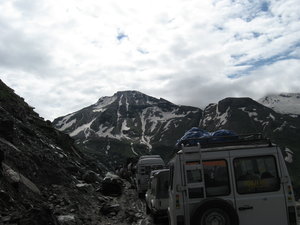Advertisement
Published: July 31st 2012

 Rohtang Pass to Leh
Rohtang Pass to Leh
Yes, this is a road.Leh is the largest village in Ladakh, and by village, I mean town. It is similar to anything one might find in the USA: it has banks and post offices, hospitals and taxis, all of the hustle and bustle that is completely unavoidable in India. What lies beyond Leh, even just 20 or 30 kilometers away where the roads end, is where Ladakh begins.
The landscape is high mountain desert. The low points sit at about 11,000 feet, and passes generally reach 15-17,000 feet. Despite the lack of roads, electricity, and telephones, life exists; it flourishes. The people work all summer to prepare for the winter, and of course the animals do, too. The allegory of the the grasshopper and ant comes to mind. It is hard to imagine Ladakh in the winter. A man at one of the homestays we slept at told us that when it starts to snow, everyone goes underground with their animals. The livestock occupies the outer-most rooms, and the family all stays together in a center room with a stove. They still use their cows, sheep, and goats as insulation.
There are wild donkeys, snow leopards, blue sheep, marmots, wild roses everywhere, and
a variety of wild rubarb that does well here even though it is perhaps one of the driest places on the planet; the landscape is reminiscent of the moon. In the villages, which always lie along a small river, there is usually a monastery on a hill, surrounded by mustard, barley, and wheat fields. Each family also has a small garden where they grow spinach, cabbage, raddishes, carrots, etc. The gardens and villages always sit at least 30 or 50 feet above the river bed, and water runs through aqueducts to irrigate crops and provide water to the houses. It is quite an ingenius use of resources that has been going on for centuries. There might be a little magic at play, too, because we are pretty sure there are some places where the water in the aqueducts runs uphill. Additionally, there is always a cow, a yak, or a dzo (a hybrid of the two) to milk. They drink the milk, and they make butter and cheese with it, too. Yak cheese is pretty tasty. Other supplies are brought in and out of the villages on the backs of donkeys, mules, and pack horses.
Roads are being built,
and along with them life is changing. I can't say whether or not the village people are happy to have the roads. The kids will be; roads also mean power lines and cell phone towers, but they also contribute to the disappearance of a way of life that has subsisted for thousands of years without much outside help. Without roads, power lines, and telephones, time and the concept of time changes. Ideas are formed around hours rather than minutes, life begins at sunrise and finishes after dinner, and people are forced to wait, to really really wait for things. Life in these places without roads knows what it is like to be truly truly hungry and truly truly tired.
Advertisement
Tot: 0.062s; Tpl: 0.014s; cc: 6; qc: 44; dbt: 0.0367s; 1; m:domysql w:travelblog (10.17.0.13); sld: 1;
; mem: 1.1mb

 Rohtang Pass to Leh
Rohtang Pass to Leh